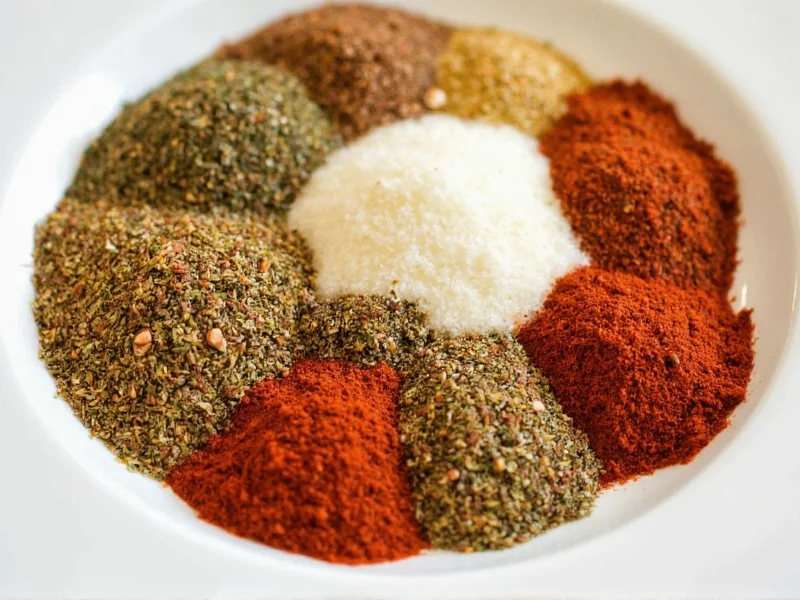Understanding what's in creole seasoning begins with recognizing its cultural roots in New Orleans. This distinctive spice blend emerged from the fusion of French, Spanish, African, and Caribbean culinary traditions that characterize Creole cooking. Unlike many commercial spice mixes, traditional Creole seasoning relies on a balanced combination of aromatic herbs and moderate heat rather than overwhelming spiciness.
Core Ingredients of Authentic Creole Seasoning
While recipes vary among families and brands, the following ingredients form the essential foundation of what is in creole seasoning:
| Ingredient | Primary Function | Typical Proportion |
|---|---|---|
| Paprika | Base flavor and color | 30-40% |
| Garlic Powder | Savory depth | 15-20% |
| Onion Powder | Sweetness and complexity | 10-15% |
| Dried Oregano | Herbal note | 5-10% |
| Dried Thyme | Earthy herbal element | 5-10% |
| Cayenne Pepper | Controlled heat | 2-5% |
| Black Pepper | Sharp warmth | 5-8% |
| White Pepper | Subtle heat with different profile | 3-5% |
| Salt | Flavor enhancer | 15-25% |
Regional Variations in Creole Seasoning Ingredients
When exploring what ingredients are in creole seasoning, you'll notice regional differences. Traditional New Orleans blends often include celery seed, which adds an earthy dimension. Some coastal variations incorporate a touch of dried shrimp or seafood seasoning, reflecting the region's culinary heritage. Home cooks might add additional elements like:
- Mustard powder for tanginess
- Parsley flakes for freshness
- Lemon pepper for citrus notes
- Coriander for floral complexity
Commercial blends sometimes include anti-caking agents like silicon dioxide or calcium silicate, which aren't part of traditional homemade versions. When examining store-bought creole seasoning ingredients, check for these additives if you prefer a pure spice blend.
Creole vs. Cajun: Understanding the Difference
One of the most common points of confusion involves understanding what's in creole seasoning versus cajun seasoning. While both originate from Louisiana cuisine, they have distinct profiles:
- Creole seasoning features more herbs (oregano, thyme) and moderate heat, reflecting New Orleans' cosmopolitan influences
- Cajun seasoning typically contains more peppers (including black pepper, cayenne, and sometimes white pepper) with fewer herbs, representing rural Acadiana's spicier profile
The key difference in what ingredients are in creole seasoning compared to Cajun is the emphasis on paprika and herbs rather than multiple pepper varieties. This makes Creole seasoning more versatile for dishes where you want flavor complexity without intense heat.
How to Use Creole Seasoning in Cooking
Knowing what's in creole seasoning helps you use it effectively. This versatile blend works well with:
- Seafood dishes (shrimp, fish, crab)
- Poultry (especially grilled or roasted chicken)
- Vegetable preparations (okra, bell peppers, tomatoes)
- Gumbo and jambalaya as a flavor base
- Meat rubs for pork and beef
For best results when using creole seasoning ingredients, add it early in the cooking process to allow flavors to meld, but avoid excessive heat that can burn the paprika. A general guideline is 1-2 teaspoons per pound of protein or 4 servings of vegetables.
Homemade Creole Seasoning Recipe
Creating your own blend ensures you know exactly what ingredients are in creole seasoning. Here's a simple authentic recipe:
Basic Creole Seasoning Blend
- ¼ cup paprika
- 2 tablespoons garlic powder
- 2 tablespoons onion powder
- 1 tablespoon dried oregano
- 1 tablespoon dried thyme
- 1½ teaspoons cayenne pepper (adjust to taste)
- 1 tablespoon black pepper
- 1½ teaspoons white pepper
- 3 tablespoons salt
Mix all ingredients thoroughly in a bowl, then store in an airtight container away from light and heat. This homemade creole seasoning recipe yields approximately 1 cup of seasoning blend. For a salt-free version, simply omit the salt and adjust other proportions accordingly.
Storage and Shelf Life of Creole Seasoning Ingredients
Proper storage maintains the quality of what's in creole seasoning. Follow these guidelines:
- Store in airtight glass or metal containers (not plastic, which can absorb odors)
- Keep away from direct sunlight and heat sources
- Use within 6 months for peak flavor (though safe indefinitely)
- Check for fading color or diminished aroma as signs of degradation
Freezing isn't recommended as moisture can cause clumping. For longest shelf life when making your own creole seasoning mix, purchase whole spices and grind them yourself just before blending.
Common Questions About Creole Seasoning Components
Understanding what ingredients are in creole seasoning helps home cooks make informed choices. This traditional blend offers a balanced flavor profile that enhances rather than overwhelms dishes. Whether you're following a classic New Orleans recipe or creating your own culinary fusion, knowing the components of authentic creole seasoning ingredients allows you to adjust and adapt to your personal taste preferences while maintaining the essence of this historic spice blend.











 浙公网安备
33010002000092号
浙公网安备
33010002000092号 浙B2-20120091-4
浙B2-20120091-4